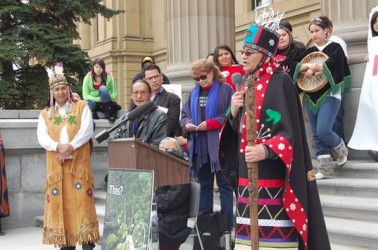Article Origin
Volume
Issue
Year
Four days after receiving a go-ahead letter for Pacific NorthWest LNG terminal from Mayor John Helin of the Lax Kw’alaams Band, the Canadian Environmental Assessment Agency (CEAA) has requested more information from Pacific NorthWest.
Environment and Climate Change Minister Catherine McKenna has granted a three-month extension.
And if that extension does not include more consultation with First Nations, Wet'suwet'en Nation Hereditary Chief Na’MOKS, says the government can expect legal action.
“Their consultation with First Nations was not complete,” he said. “We’ve approached (the federal government) and informed them numerous times that if the decision is against our wishes, next step (will be) legal cases, up and down the river, right down to the coast.”
Na’MOKS says the warning was issued just last week, when a delegation met in Ottawa with CEAA, and the departments of environment and climate change, and fisheries and oceans.
Consultation to this point, he says, has been limited specifically to the pipe and site of the liquefied natural gas facility despite the fact that all the water runs through the mouth of the Skeena River.
Na’MOKS points out that none of the upriver people, including his Nation, were consulted on the plant.
“We’re adamantly opposed to the site of that plant,” he said. “It could not be a worse site than right at the mouth of the second largest salmon run in Canada.”
While Na’MOKS is encouraged by the government’s stop order, he says it can be rescinded anytime.
“Prime Minister [Justin] Trudeau, he had made promises to First Nations that we would be fully consulted and that has not happened,” he said. “The ball is in their court.”
In January, a two-day Salmon Nation Summit concluded with the signing of the Lelu Island Declaration by hereditary leaders from the Nine Allied Tribes of the Lax Kw'alaams First Nation, and hereditary leaders of the Gitxsan, Wet'suwet'en, Lake Babine, and Haisla First Nations, and Grand Chief Stewart Phillip of the Union of B.C. Indian Chiefs. The declaration stated that Lelu Island and Flora and Agnew banks “were hereby protected for all time,” a resounding rejection of the Pacific NorthWest’s LNG facility.
Na’MOKS questions whether Lax Kw’alaams Band members were consulted before Helin reversed a previous decision stating that Lax Kw’alaams remained opposed to the LNG facility. The opposition letter was dated March 7. The new letter, dated March 15, supports the project and includes two conditions: that Pacific NorthWest report to an environmental performance committee, which will have representation from Lax Kw’alaams Band, and, that that the environmental performance committee provide direction to Pacific NorthWest, which the company must follow.
“Two minor conditions to change their mind, I’m not sure what public consultation (Helin) had with his own people on that,” said Na’MOKS, adding he heard nothing about such a meeting. “That came as a shock. We’re pretty much in the loop because we’re all from the northwest here.”
Na’MOKS would not comment on whether the Pacific Northwest LNG project was lining up to be a fight between hereditary chiefs and the elected band council. However, he did say that Chief Yahaan of the Gitwilgyoots Tribe said that (the hereditary leadership) were “the true decision makers” on their territory.
Na’MOKS expects Lax Kw’alaams Band membership will want to have another vote on the facility. In the spring of 2015, membership unanimously rejected a $1.15-billion benefits package from the company and the B.C. government that included cash and land.
Helin — who replaced former mayor Garry Reece in last November’s election —did not respond Monday to repeated requests by Windspeaker for an interview.
In a news release issued by the CEAA announcing the deadline extension, the agency stated it “will continue to work diligently with the technical working group for the project, including Indigenous groups and federal experts, to review the information and finalize the environmental assessment report and conditions.”
- 2758 views

